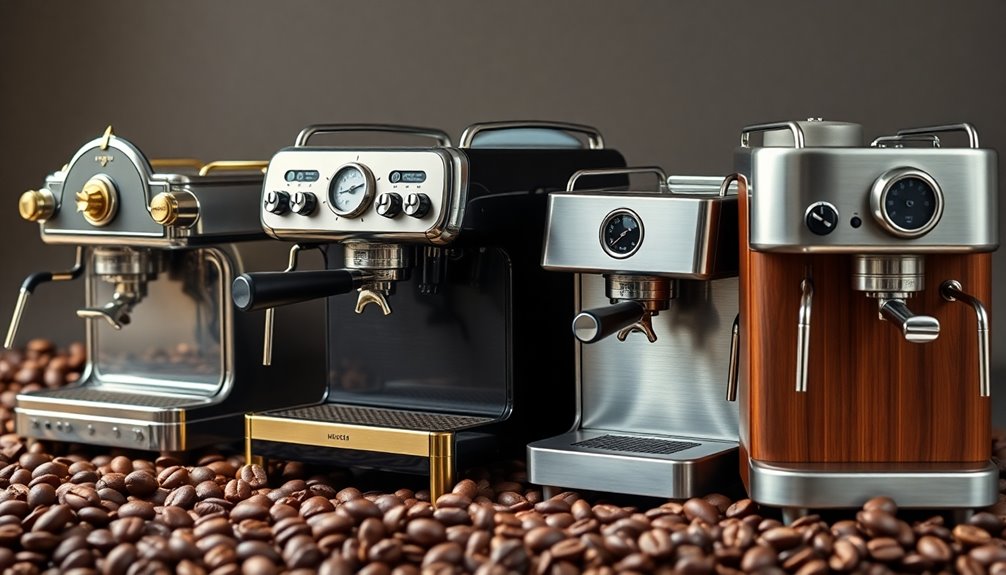Espresso machines have evolved considerably since their inception in the 1880s. You’ll find they’ve changed from steam-powered prototypes to electric machines that offer precise control over pressure and temperature. Innovations like dual boiler systems and adjustable flow rates enhance brewing efficiency and flavor extraction. Digitalisation and stylish designs cater to both baristas and coffee lovers today. With a growing focus on sustainability, the future looks bright for espresso technology; you’ll discover even more fascinating details ahead.
Key Takeaways
- The first espresso machine, patented in 1884 by Angelo Moriondo, utilized steam but lacked efficiency compared to modern designs.
- The introduction of electric pumps in the early 1900s allowed for greater control over brewing pressure and temperature, enhancing flavor quality.
- Innovations like the E61 machine in 1961 standardized brewing pressure at nine bars, improving extraction consistency and flavor richness.
- Digitalisation has revolutionized espresso machines, offering precise control over brewing parameters and energy-saving features, improving user experience.
- A growing focus on sustainability has led manufacturers to create energy-efficient machines while maintaining high-quality espresso production.
The Origins of Espresso Machines
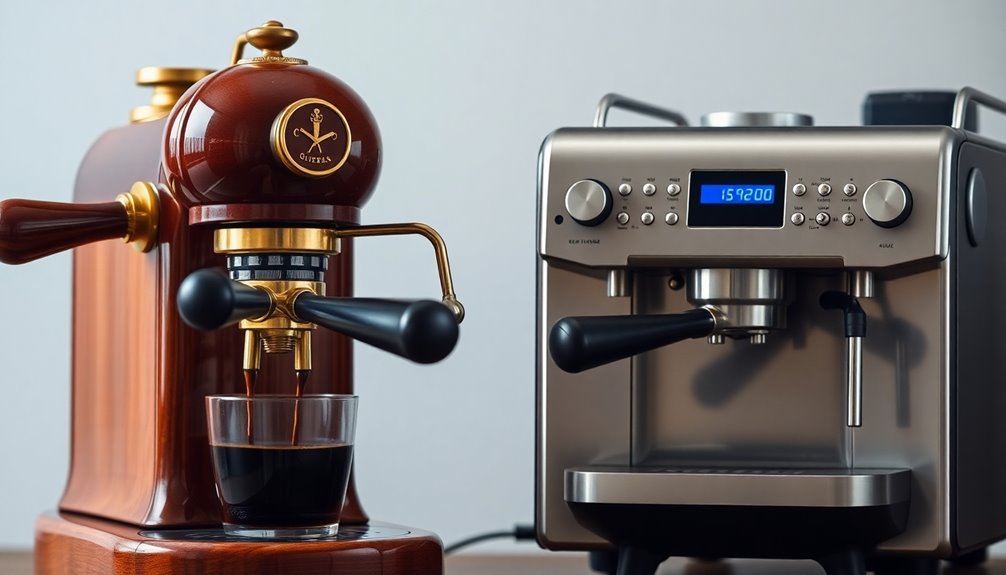
The journey of espresso machines began in 1884 when Angelo Moriondo patented the first prototype, designed to brew coffee in bulk using steam. This innovation laid the groundwork for future advancements.
In the early 1900s, Luigi Bezzera refined the espresso machine, introducing features like the portafilter and multiple brewheads, allowing for single-shot espresso extraction.
Desiderio Pavoni later acquired Bezzera’s patents and invented the first pressure release valve and steam wand, greatly enhancing the brewing process and machine efficiency. Their collaboration led to the Ideale machine showcased at the 1906 Milan Fair, bringing café espresso to the public.
Desiderio Pavoni revolutionized espresso machines with the first pressure release valve and steam wand, enhancing brewing efficiency and public accessibility.
The post-World War II era saw Achille Gaggia’s lever-driven machine, which increased brewing pressure, producing a richer espresso with crema and standardizing shot sizes. This evolution parallels the advancements in color accuracy seen in home cinema projectors, highlighting the importance of precision in crafting quality experiences.
Early Innovations and Key Inventors
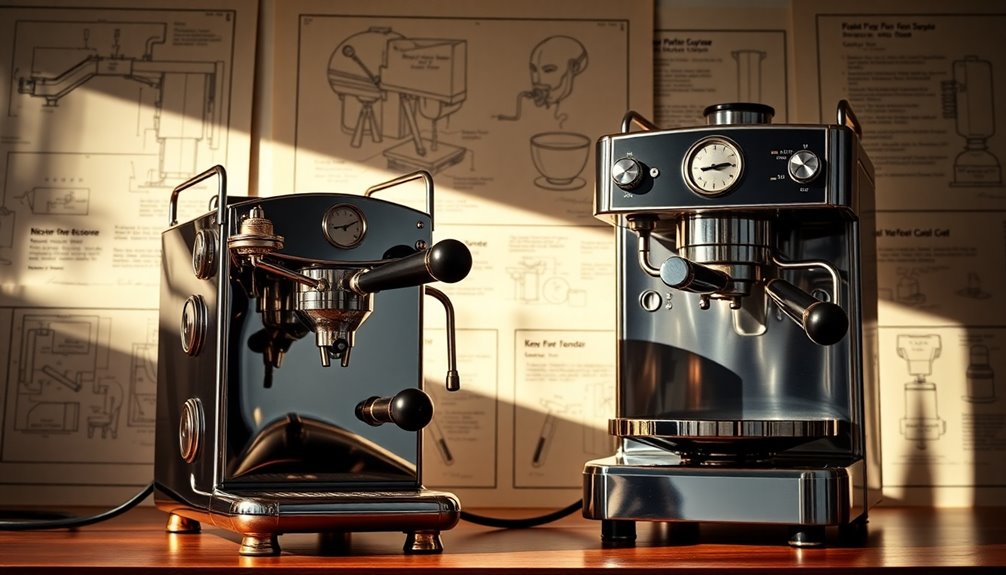
While espresso machines have evolved considerably over the years, early innovations and the vision of key inventors laid the foundation for modern brewing. Angelo Moriondo patented the first espresso machine in 1884, using steam power but focusing on bulk production. Luigi Bezzera enhanced this design in the early 1900s, introducing the portafilter and multiple brewheads for single servings. Desiderio Pavoni further improved the process with a pressure release valve and steam wand. Achille Gaggia’s lever-driven machine in 1946 raised brewing pressure, creating rich crema. Finally, Ernesto Valente’s E61 machine in 1961 revolutionized brewing with a motorized pump, ensuring consistent nine-bar pressure. The evolution of espresso machines reflects advancements similar to those seen in farmhouse kitchen cabinet ideas, emphasizing both functionality and aesthetics.
| Inventor | Year | Key Innovation |
|---|---|---|
| Angelo Moriondo | 1884 | First espresso machine |
| Luigi Bezzera | Early 1900s | Portafilter, brewheads |
| Desiderio Pavoni | 1903 | Pressure release valve |
| Achille Gaggia | 1946 | Increased brewing pressure |
Transition From Steam to Electric Machines
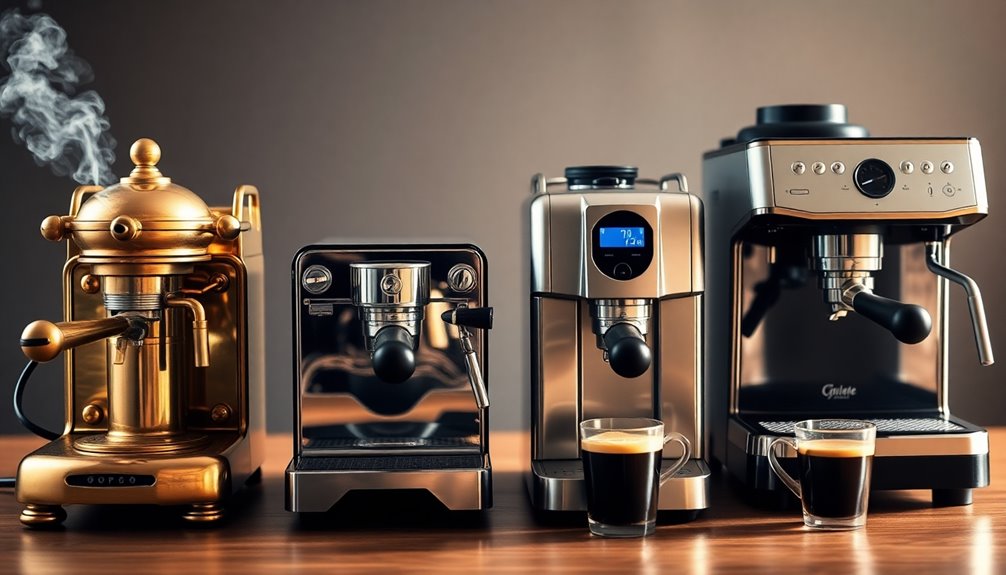
As you explore the shift from steam to electric espresso machines, you’ll notice how early steam machines laid the groundwork for innovation.
The emergence of electric pumps revolutionized brewing, giving you greater control over pressure and temperature.
Modern efficiency innovations have since transformed the way cafés serve high-quality coffee, making every cup more consistent than ever.
Additionally, advancements in technology have led to the development of best espresso machines that cater to various budgets and preferences, enhancing the home brewing experience.
Early Steam Machines
Though early steam machines paved the way for espresso brewing, they often fell short in efficiency and quality compared to today’s standards. Invented by Angelo Moriondo in 1884, these machines relied on steam pressure but lacked key features. Luigi Bezzera later introduced the portafilter and multiple brewheads, yet brewing consistency remained an issue due to poor pressure control. Desiderio Pavoni’s pressure release valve in 1903 marked a turning point, improving quality. As you explore this evolution, consider how innovations led to the eventual rise of electric machines. The development of the refrigeration cycle in heating and cooling technologies has parallels in how espresso machines have adapted to improve performance and consistency.
| Key Features | Impact |
|---|---|
| Steam Machines | Limited efficiency |
| Pressure Release Valve | Enhanced brewing consistency |
| Lever-Driven Machine | Improved flavor extraction |
Emergence of Electric Pumps
With the introduction of electric pumps in the early 1960s, espresso machines underwent a revolutionary transformation that fundamentally changed the brewing process.
You’ll notice that these electric pumps allowed for consistent brewing pressure, essential for crafting high-quality espresso with rich crema. Unlike steam machines, which often produced burnt flavors, electric machines enhanced the overall flavor of the espresso.
The shift also made espresso machines more compact and user-friendly, letting you focus on perfecting your technique instead of dealing with mechanical adjustments.
This evolution not only improved espresso brewing but also set the stage for further innovations in espresso machine technology, including better temperature management and digital controls, ensuring a consistently excellent cup every time. Additionally, the increased reliance on technology in espresso machines reflects the broader trend of investment in innovation, which is crucial for staying competitive in the market.
Modern Efficiency Innovations
While traditional steam machines laid the groundwork for espresso brewing, the shift to electric machines brought about a new era of efficiency and precision.
Electric pumps revolutionized pressure control, ensuring consistent brewing conditions that steam systems struggled to maintain. The introduction of the E61 machine in 1961 enabled ideal extraction, enhancing flavor consistency with its nine-bar pressure.
Compact designs replaced bulky steam boilers, streamlining café workflows. Dual boiler systems, pioneered by La Marzocco, allowed for independent temperature control for brewing and steaming, elevating drink quality.
Finally, innovations like PID controllers fine-tuned temperature control, guaranteeing water stays at the perfect heat for extraction. These efficiency innovations transformed how you enjoy espresso, making each cup more consistent and flavorful than ever before, much like HEPA filtration enhances air quality in air purifiers.
The Rise of Pressure and the Lever System
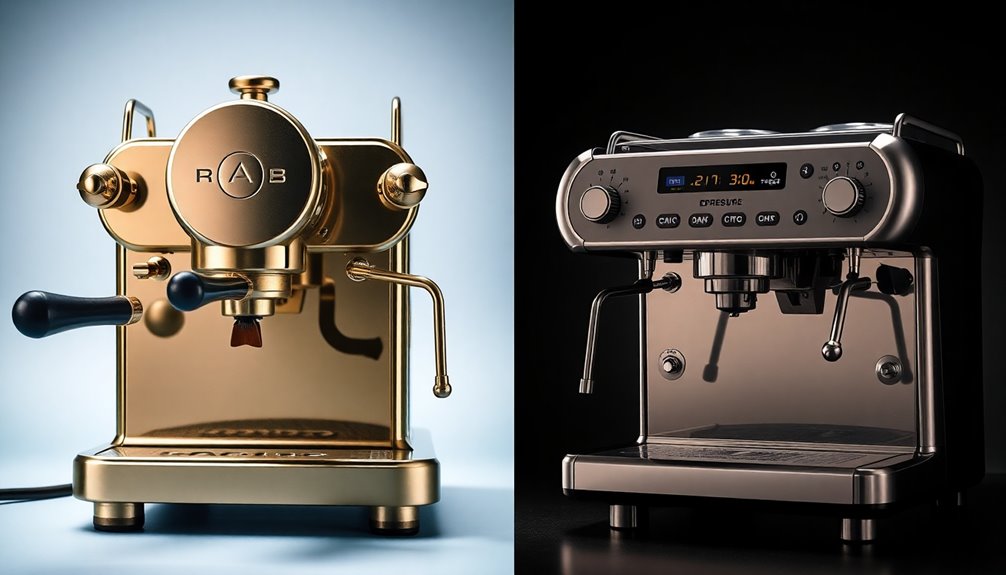
As espresso enthusiasts sought richer flavors and better extraction, the introduction of the lever system by Achille Gaggia in 1946 marked a pivotal moment in espresso machine evolution.
This system allowed you to manually pull a lever, achieving brewing pressures of 8-10 bars. Such pressure greatly enhanced extraction quality within just 30-45 seconds, creating that coveted crema—an indicator of high-quality espresso.
Lever-driven machines standardized shots at one ounce, ensuring consistent quality with every brew.
The iconic Faema E61, developed in 1961, took this innovation further by incorporating a motorized pump that maintained consistent pressure, solidifying its status as a foundational model for modern espresso machines.
This evolution truly transformed the brewing experience for enthusiasts everywhere, paving the way for advancements in super automatic espresso machines that further simplified home brewing.
Dual Boiler Technology and Temperature Control
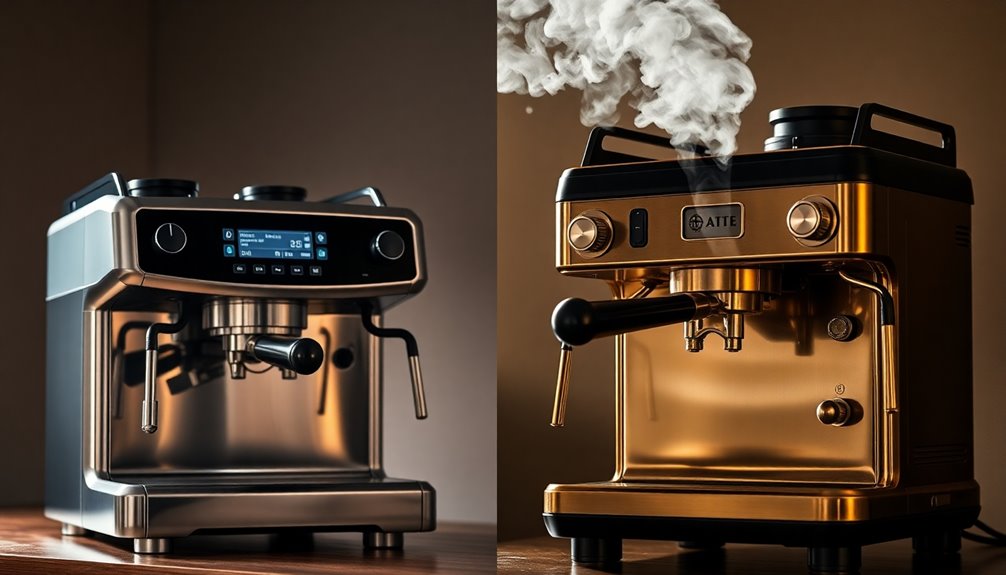
The evolution of espresso machines took a significant leap forward when dual boiler technology emerged in the 1970s, revolutionizing how baristas craft espresso.
This innovation allows for precise temperature control, enhancing espresso quality and versatility.
Here’s what makes dual boiler systems essential for modern cafés:
- Consistent Brewing: Maintain temperatures between 93-100°C (199-212°F) while steaming milk.
- PID Controllers: Guarantee temperature stability during the brewing process for ideal results.
- Multi-Boiler Systems: Enable multiple group heads to operate independently, improving workflow.
- Flavor Extraction: Adjustable valves help prevent channeling, enhancing flavor extraction in every shot.
With these advancements, baristas can deliver exceptional espresso consistently, making dual boiler technology a game changer in the coffee world. Additionally, energy-efficient operation in these machines contributes to lower electricity costs while maintaining high performance.
Flow Rate Management and Extraction Techniques
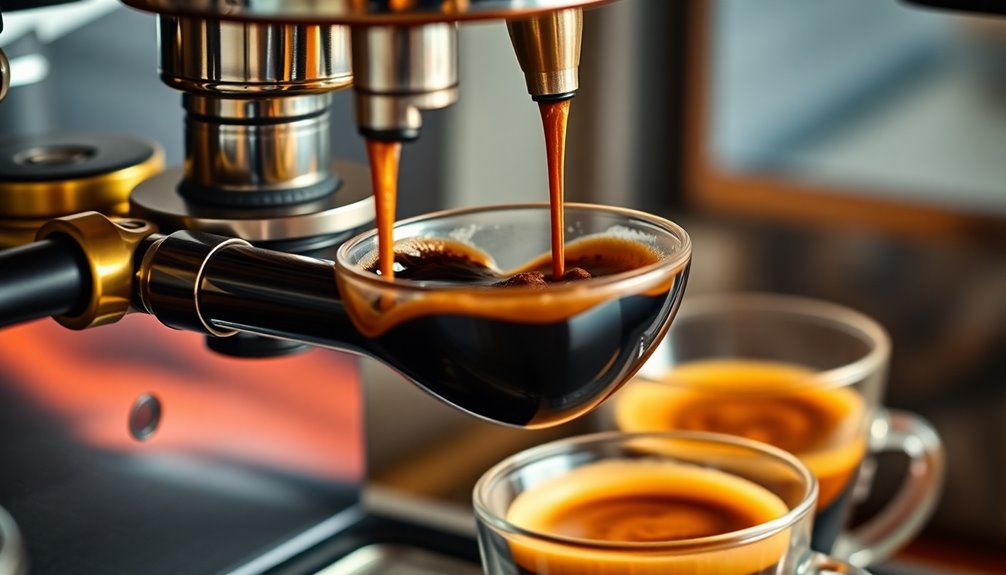
Understanding flow rate management and extraction techniques is essential for any barista aiming to elevate their espresso game.
Modern espresso machines allow you to control water flow, preventing channeling and enhancing flavor extraction. By using adjustable valves, you can precisely manage water flow during pre-infusion, ensuring uniform saturation of the coffee puck.
Maintaining consistent brewing temperatures between 93-100°C (199-212°F) is vital for high-quality espresso, thanks to advanced temperature control systems like PID controllers.
Additionally, recent innovations enable manipulation of water volume and pressure management during extraction, giving you the flexibility to tailor the brewing process to specific coffee beans. This evolution reflects broader trends in sustainability and responsible investing, as many manufacturers focus on energy-efficient designs.
Mastering these techniques is key to revealing the full potential of your espresso, resulting in superior taste and aroma.
The Impact of Digitalisation and Automation
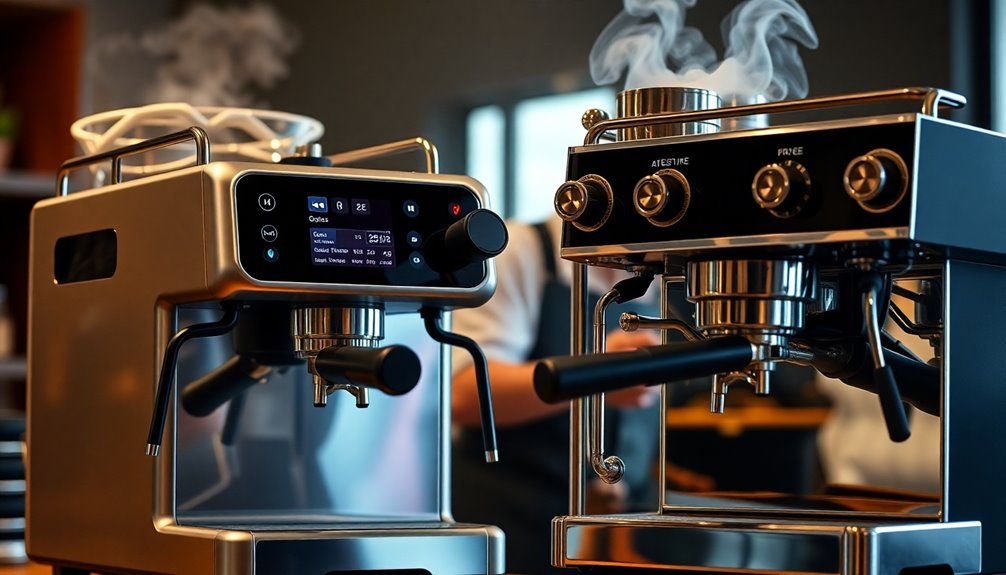
With digitalisation driving changes in the coffee industry, modern espresso machines are now equipped with cutting-edge technology that allows for precise control over brewing parameters.
This evolution has streamlined the brewing process, making it easier for you to achieve that perfect cup. Here are some key benefits:
- Temperature Control: Maintain the ideal brewing temperature for maximum flavor extraction.
- Pressure Control: Achieve consistent pressure throughout the extraction process, enhancing your coffee’s taste.
- Water Volume: Adjust the exact amount of water for each brew, ensuring consistency with every cup.
- Energy Efficiency: Innovations like energy-saving modes cut power consumption considerably.
With automation and digital technology, you can now enjoy remote adjustments and real-time monitoring, making your coffee experience both efficient and delightful. Additionally, understanding the differences between espresso and coffee can help you appreciate the nuances of your brew even further.
Aesthetic Evolution and Design Trends
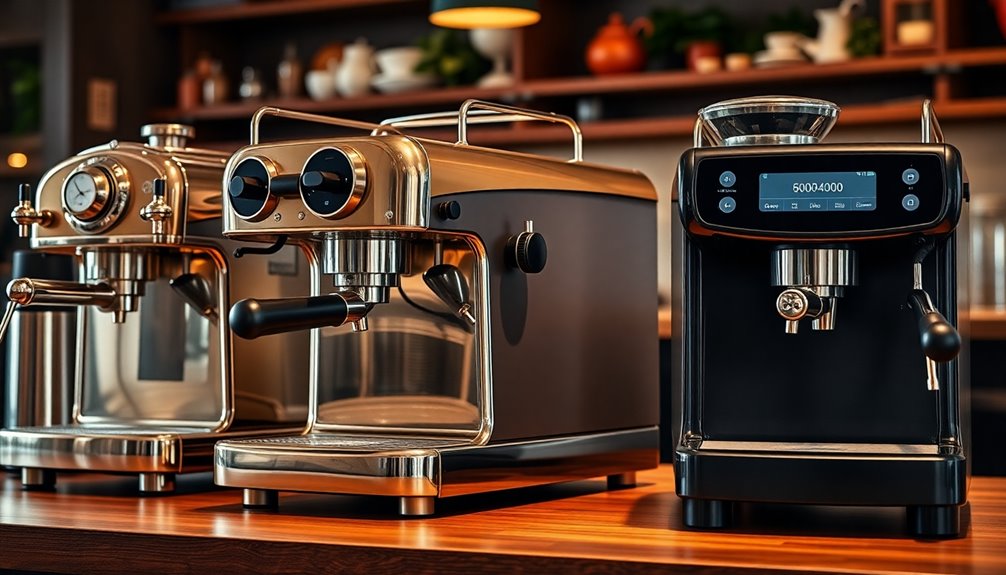
As you explore the world of espresso machines, you’ll notice a shift towards ergonomic features that enhance usability and comfort.
Designers are also opting for trendy materials that not only look great but also boost durability and sustainability.
With social media’s influence, these machines have become eye-catching pieces that elevate any café’s vibe.
Ergonomic Features Enhancement
While the evolution of espresso machines has focused on technical advancements, a significant shift toward ergonomic features has transformed their design.
Today, these machines prioritize ease of use for baristas and enhance customer interaction. You’ll notice:
- Customizable design elements that let café owners express their brand identity.
- Minimalist designs that contribute to the aesthetic evolution, making machines visually appealing.
- Smaller boilers and pumps optimize counter space, ensuring an efficient workflow.
- High-quality materials enhance both functionality and visual appeal.
This blend of ergonomic features and stylish aesthetics creates machines that not only perform well but also fit seamlessly in trendy café environments, catering to both baristas and coffee lovers alike.
Trendy Material Choices
The focus on ergonomic features has naturally led to a shift in material choices for espresso machines, reflecting the modern café’s aesthetic demands.
Today, stainless steel and aluminum dominate, providing a sleek and minimalist look that enhances both functionality and visual appeal. These materials not only promise durability but also lend a polished appearance that attracts café owners and customers alike.
Customizable design options have emerged, allowing you to express your brand through unique color schemes and finishes, further enriching the customer experience.
Influenced by Art Deco and mid-century modern styles, espresso machines now showcase clean lines and ergonomic features that align with contemporary interior design trends, making them as much a statement piece as a functional tool in your café.
Social Media Appeal
In today’s café culture, espresso machines have become more than just functional tools; they’re essential elements of the aesthetic experience.
With the rise of social media, coffee shop owners are keenly aware of how their machines contribute to the café ambiance. Here are some trends shaping their appeal:
- Modern Lines: Sleek designs attract attention and fit perfectly into contemporary settings.
- Customizable Design: Owners can tailor machines to reflect their brand, enhancing visual impact.
- High-Quality Materials: Polished finishes elevate the overall look, making them Instagram-worthy.
- Efficient Machines: Smaller designs optimize space while maintaining functionality, appealing to both baristas and customers.
These factors make espresso machines not just efficient but also attractive backdrops for social media moments.
Future Prospects and Sustainability in Espresso Machines
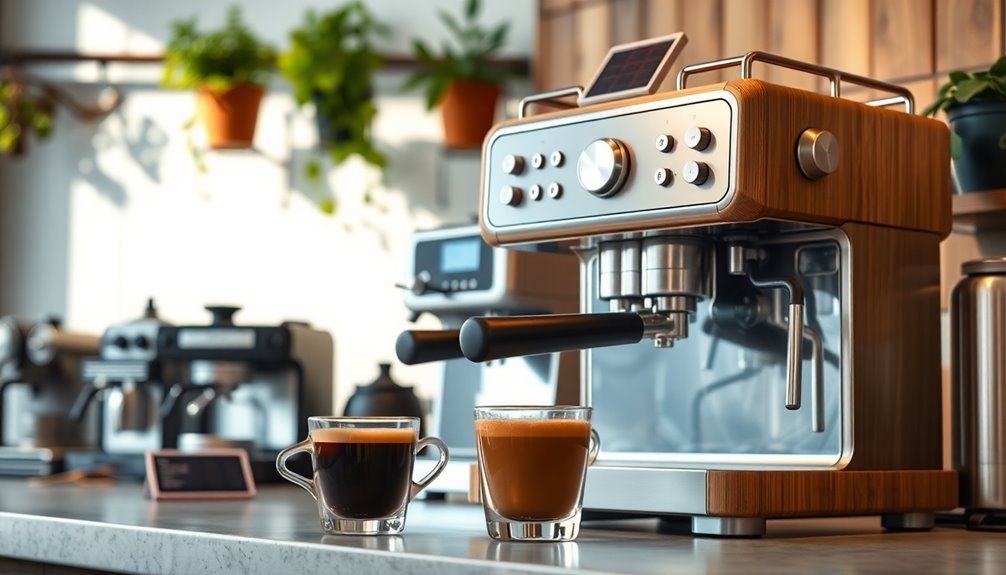
As consumer awareness of environmental issues grows, espresso machine manufacturers are stepping up their game by prioritizing sustainability in their designs. Innovations like Dalla Corte’s Zero machine showcase energy efficiency, cutting power consumption by over 80%.
You’ll notice that future machines will avoid long heating times while maintaining peak performance, making your espresso experience more enjoyable. Digital integration is set to evolve, allowing for remote adjustments and improved energy management, which reduces waste.
Additionally, expect customizable aesthetics and ergonomic features that enhance your café experience, blending functionality with visual appeal. The ongoing commitment to producing high-quality espresso while embracing sustainable practices will certainly shape the future of espresso machines, ensuring you’re environmentally conscious without sacrificing taste.
Frequently Asked Questions
How Have Coffee Makers Changed Over Time?
Coffee makers have changed dramatically over time to meet your brewing needs.
You’ve gone from simple drip machines to sophisticated models featuring programmable settings and built-in grinders.
Today, you can enjoy single-serve options, pour-over systems, and even smart coffee makers that connect to your phone.
With advancements in technology, you’re able to customize brew strength, temperature, and even receive alerts when your coffee is ready, making your morning routine more convenient and enjoyable.
What Year Was the First Espresso Machine Invented?
You might think the invention of the espresso machine was a monumental moment in coffee history—and you’d be right!
The first espresso machine was patented by Angelo Moriondo in 1884. This groundbreaking device was designed for bulk brewing rather than single servings.
It set the stage for future innovations that would revolutionize how we enjoy espresso.
How Did Italians Make Espresso Before Electricity?
Before electricity, Italians used steam-powered machines to make espresso.
You’d watch as these machines relied on direct heat, often resulting in inconsistent quality.
With open flame heating, maintaining the right water temperature was tricky, leading to less than ideal brews.
While these early devices could whip up large quantities quickly, they couldn’t match the flavor and precision of the electric machines that transformed espresso into the beloved beverage we enjoy today.
How Many Years Does an Espresso Machine Last?
So, you think your espresso machine‘s a lifelong friend? Well, it might stick around for 5 to 15 years if you treat it right!
Commercial machines often last 10 to 15 years, while home models usually hang in there for about 5 to 10.
Regular servicing and quality materials can definitely help, but don’t expect it to last forever!
Just remember, it’s a machine, not a pet—no need for a birthday party!
Conclusion
So, as you sip your perfectly brewed espresso, it’s amusing to think that just a century ago, folks were wrestling with steam-powered contraptions. You’ve got machines now that practically make coffee by themselves, yet you can still find yourself staring at a manual, wondering how to froth milk. Isn’t it funny how technology has evolved, only to keep you guessing? But hey, at least your morning ritual has never been easier—unless, of course, you forget to plug it in!
